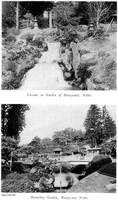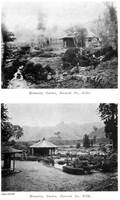Plate XXXII. is illustrative of the well-known garden of a monastery called the Dainichi-Do, at Nikko. It is situated in a little depression and prettily arranged so as to take advantage of the view of the surrounding hills and woods. A few flowering trees, willows, and pines, are introduced into the grounds, which are for the most part ornamented with formally clipped box, azalea and juniper bushes, here and there trained into the shape of long hedges. The centre is occupied by a miniature lake supplied by an underground spring of the purest water; its deep bubbling pools are surrounded by rocks thickly coated with moss. A red lacquered shrine, dedicated to the god Dainichi, flanks the lake, and several stone lanterns of unusual shape, a miniature stone pagoda, and numerous garden rocks, are grouped together on the banks of the pool. Plate XXXIII. shows the grounds of another monastery at Nikko, known as the Mangwanji. A large lake in front of the main building contains islands representing the crane and tortoise�felicitous emblems in Japanese art. Fine rocks and evergreens adorn the level areas of the garden, which is bordered by clumps of old trees and thick hedges. The lower view given in Plate XXXIII. exhibits the narrow inlet of the lake crossed by a curved wooden bridge, at the side of which are large rounded bushes and a leaning pine-tree. One or two stone lanterns and a detached summer-house may be seen in the background. The lower illustration shows the waterfall, arranged in two low torrents flanked by rocks, and, a life-sized stone statue of Fudo,�the deity to whom all waterfalls in Japan are dedicated,�at the head of the cascade. Two stone pagodas of different shapes may be observed on the surrounding banks, and also a shed from which the view of the cascade can be enjoyed.



